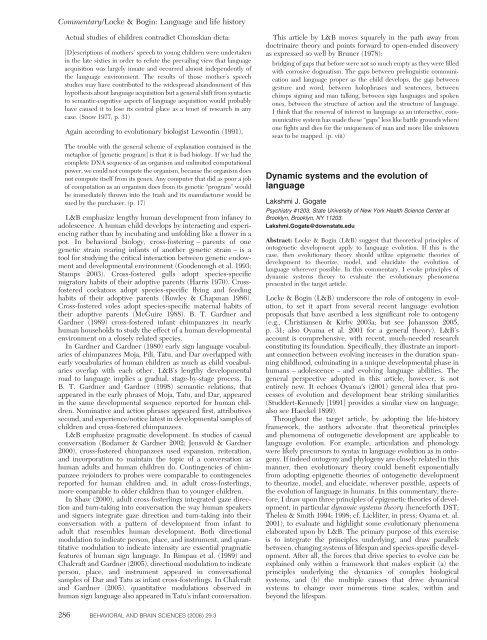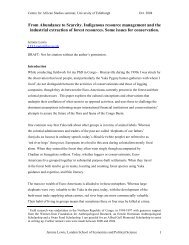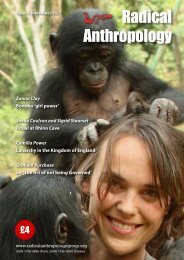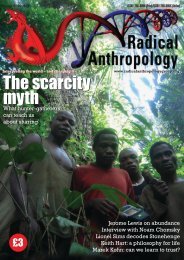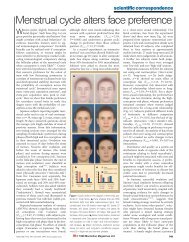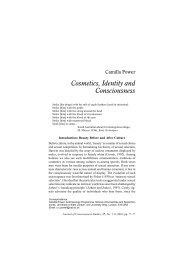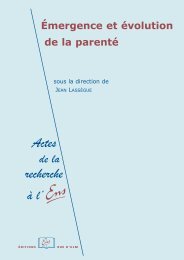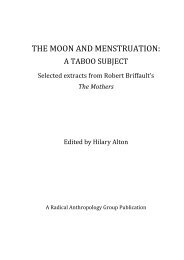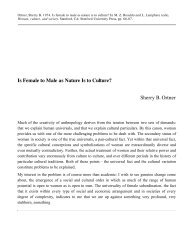Language and life history: A new perspective on the development ...
Language and life history: A new perspective on the development ...
Language and life history: A new perspective on the development ...
- No tags were found...
You also want an ePaper? Increase the reach of your titles
YUMPU automatically turns print PDFs into web optimized ePapers that Google loves.
Commentary/Locke & Bogin: <str<strong>on</strong>g>Language</str<strong>on</strong>g> <str<strong>on</strong>g>and</str<strong>on</strong>g> <str<strong>on</strong>g>life</str<strong>on</strong>g> <str<strong>on</strong>g>history</str<strong>on</strong>g>Actual studies of children c<strong>on</strong>tradict Chomskian dicta:[D]escripti<strong>on</strong>s of mo<strong>the</strong>rs’ speech to young children were undertakenin <strong>the</strong> late sixties in order to refute <strong>the</strong> prevailing view that languageacquisiti<strong>on</strong> was largely innate <str<strong>on</strong>g>and</str<strong>on</strong>g> occurred almost independently of<strong>the</strong> language envir<strong>on</strong>ment. The results of those mo<strong>the</strong>r’s speechstudies may have c<strong>on</strong>tributed to <strong>the</strong> widespread ab<str<strong>on</strong>g>and</str<strong>on</strong>g><strong>on</strong>ment of thishypo<strong>the</strong>sis about language acquisiti<strong>on</strong> but a general shift from syntacticto semantic-cognitive aspects of language acquisiti<strong>on</strong> would probablyhave caused it to lose its central place as a tenet of research in anycase. (Snow 1977, p. 31)Again according to evoluti<strong>on</strong>ary biologist Lew<strong>on</strong>tin (1991),The trouble with <strong>the</strong> general scheme of explanati<strong>on</strong> c<strong>on</strong>tained in <strong>the</strong>metaphor of [genetic program] is that it is bad biology. If we had <strong>the</strong>complete DNA sequence of an organism <str<strong>on</strong>g>and</str<strong>on</strong>g> unlimited computati<strong>on</strong>alpower, we could not compute <strong>the</strong> organism, because <strong>the</strong> organism doesnot compute itself from its genes. Any computer that did as poor a jobof computati<strong>on</strong> as an organism does from its genetic “program” wouldbe immediately thrown into <strong>the</strong> trash <str<strong>on</strong>g>and</str<strong>on</strong>g> its manufacturer would besued by <strong>the</strong> purchaser. (p. 17)L&B emphasize lengthy human <strong>development</strong> from infancy toadolescence. A human child develops by interacting <str<strong>on</strong>g>and</str<strong>on</strong>g> experiencingra<strong>the</strong>r than by incubating <str<strong>on</strong>g>and</str<strong>on</strong>g> unfolding like a flower in apot. In behavioral biology, cross-fostering – parents of <strong>on</strong>egenetic strain rearing infants of ano<strong>the</strong>r genetic strain – is atool for studying <strong>the</strong> critical interacti<strong>on</strong> between genetic endowment<str<strong>on</strong>g>and</str<strong>on</strong>g> <strong>development</strong>al envir<strong>on</strong>ment (Goodenough et al. 1993;Stamps 2003). Cross-fostered gulls adopt species-specificmigratory habits of <strong>the</strong>ir adoptive parents (Harris 1970). Crossfosteredcockatoos adopt species-specific flying <str<strong>on</strong>g>and</str<strong>on</strong>g> feedinghabits of <strong>the</strong>ir adoptive parents (Rowley & Chapman 1986).Cross-fostered voles adopt species-specific maternal habits of<strong>the</strong>ir adoptive parents (McGuire 1988). B. T. Gardner <str<strong>on</strong>g>and</str<strong>on</strong>g>Gardner (1989) cross-fostered infant chimpanzees in nearlyhuman households to study <strong>the</strong> effect of a human <strong>development</strong>alenvir<strong>on</strong>ment <strong>on</strong> a closely related species.In Gardner <str<strong>on</strong>g>and</str<strong>on</strong>g> Gardner (1980) early sign language vocabulariesof chimpanzees Moja, Pili, Tatu, <str<strong>on</strong>g>and</str<strong>on</strong>g> Dar overlapped wi<strong>the</strong>arly vocabularies of human children as much as child vocabulariesoverlap with each o<strong>the</strong>r. L&B’s lengthy <strong>development</strong>alroad to language implies a gradual, stage-by-stage process. InB. T. Gardner <str<strong>on</strong>g>and</str<strong>on</strong>g> Gardner (1998) semantic relati<strong>on</strong>s, thatappeared in <strong>the</strong> early phrases of Moja, Tatu, <str<strong>on</strong>g>and</str<strong>on</strong>g> Dar, appearedin <strong>the</strong> same <strong>development</strong>al sequence reported for human children.Nominative <str<strong>on</strong>g>and</str<strong>on</strong>g> acti<strong>on</strong> phrases appeared first, attributivessec<strong>on</strong>d, <str<strong>on</strong>g>and</str<strong>on</strong>g> experience/notice latest in <strong>development</strong>al samples ofchildren <str<strong>on</strong>g>and</str<strong>on</strong>g> cross-fostered chimpanzees.L&B emphasize pragmatic <strong>development</strong>. In studies of casualc<strong>on</strong>versati<strong>on</strong> (Bodamer & Gardner 2002; Jensvold & Gardner2000), cross-fostered chimpanzees used expansi<strong>on</strong>, reiterati<strong>on</strong>,<str<strong>on</strong>g>and</str<strong>on</strong>g> incorporati<strong>on</strong> to maintain <strong>the</strong> topic of a c<strong>on</strong>versati<strong>on</strong> ashuman adults <str<strong>on</strong>g>and</str<strong>on</strong>g> human children do. C<strong>on</strong>tingencies of chimpanzeerejoinders to probes were comparable to c<strong>on</strong>tingenciesreported for human children <str<strong>on</strong>g>and</str<strong>on</strong>g>, in adult cross-fosterlings,more comparable to older children than to younger children.In Shaw (2000), adult cross-fosterlings integrated gaze directi<strong>on</strong><str<strong>on</strong>g>and</str<strong>on</strong>g> turn-taking into c<strong>on</strong>versati<strong>on</strong> <strong>the</strong> way human speakers<str<strong>on</strong>g>and</str<strong>on</strong>g> signers integrate gaze directi<strong>on</strong> <str<strong>on</strong>g>and</str<strong>on</strong>g> turn-taking into <strong>the</strong>irc<strong>on</strong>versati<strong>on</strong> with a pattern of <strong>development</strong> from infant toadult that resembles human <strong>development</strong>. Both directi<strong>on</strong>almodulati<strong>on</strong> to indicate pers<strong>on</strong>, place, <str<strong>on</strong>g>and</str<strong>on</strong>g> instrument, <str<strong>on</strong>g>and</str<strong>on</strong>g> quantitativemodulati<strong>on</strong> to indicate intensity are essential pragmaticfeatures of human sign language. In Rimpau et al. (1989) <str<strong>on</strong>g>and</str<strong>on</strong>g>Chalcraft <str<strong>on</strong>g>and</str<strong>on</strong>g> Gardner (2005), directi<strong>on</strong>al modulati<strong>on</strong> to indicatepers<strong>on</strong>, place, <str<strong>on</strong>g>and</str<strong>on</strong>g> instrument appeared in c<strong>on</strong>versati<strong>on</strong>alsamples of Dar <str<strong>on</strong>g>and</str<strong>on</strong>g> Tatu as infant cross-fosterlings. In Chalcraft<str<strong>on</strong>g>and</str<strong>on</strong>g> Gardner (2005), quantitative modulati<strong>on</strong>s observed inhuman sign language also appeared in Tatu’s infant c<strong>on</strong>versati<strong>on</strong>.This article by L&B moves squarely in <strong>the</strong> path away fromdoctrinaire <strong>the</strong>ory <str<strong>on</strong>g>and</str<strong>on</strong>g> points forward to open-ended discoveryas expressed so well by Bruner (1978):bridging of gaps that before were not so much empty as <strong>the</strong>y were filledwith corrosive dogmatism. The gaps between prelinguistic communicati<strong>on</strong><str<strong>on</strong>g>and</str<strong>on</strong>g> language proper as <strong>the</strong> child develops, <strong>the</strong> gap betweengesture <str<strong>on</strong>g>and</str<strong>on</strong>g> word, between holophrases <str<strong>on</strong>g>and</str<strong>on</strong>g> sentences, betweenchimps signing <str<strong>on</strong>g>and</str<strong>on</strong>g> man talking, between sign languages <str<strong>on</strong>g>and</str<strong>on</strong>g> spoken<strong>on</strong>es, between <strong>the</strong> structure of acti<strong>on</strong> <str<strong>on</strong>g>and</str<strong>on</strong>g> <strong>the</strong> structure of language.I think that <strong>the</strong> re<str<strong>on</strong>g>new</str<strong>on</strong>g>al of interest in language as an interactive, communicativesystem has made <strong>the</strong>se “gaps” less like battle grounds where<strong>on</strong>e fights <str<strong>on</strong>g>and</str<strong>on</strong>g> dies for <strong>the</strong> uniqueness of man <str<strong>on</strong>g>and</str<strong>on</strong>g> more like unknownseas to be mapped. (p. viii)Dynamic systems <str<strong>on</strong>g>and</str<strong>on</strong>g> <strong>the</strong> evoluti<strong>on</strong> oflanguageLakshmi J. GogatePsychiatry #1203, State University of New York Health Science Center atBrooklyn, Brooklyn, NY 11203.Lakshmi.Gogate@downstate.eduAbstract: Locke & Bogin (L&B) suggest that <strong>the</strong>oretical principles of<strong>on</strong>togenetic <strong>development</strong> apply to language evoluti<strong>on</strong>. If this is <strong>the</strong>case, <strong>the</strong>n evoluti<strong>on</strong>ary <strong>the</strong>ory should utilize epigenetic <strong>the</strong>ories of<strong>development</strong> to <strong>the</strong>orize, model, <str<strong>on</strong>g>and</str<strong>on</strong>g> elucidate <strong>the</strong> evoluti<strong>on</strong> oflanguage wherever possible. In this commentary, I evoke principles ofdynamic systems <strong>the</strong>ory to evaluate <strong>the</strong> evoluti<strong>on</strong>ary phenomenapresented in <strong>the</strong> target article.Locke & Bogin (L&B) underscore <strong>the</strong> role of <strong>on</strong>togeny in evoluti<strong>on</strong>,to set it apart from several recent language evoluti<strong>on</strong>proposals that have ascribed a less significant role to <strong>on</strong>togeny(e.g., Christiansen & Kirby 2003a; but see Johanss<strong>on</strong> 2005,p. 31; also Oyama et al. 2001 for a general <strong>the</strong>ory). L&B’saccount is comprehensive, with recent, much-needed researchc<strong>on</strong>stituting its foundati<strong>on</strong>. Specifically, <strong>the</strong>y illustrate an importantc<strong>on</strong>necti<strong>on</strong> between evolving increases in <strong>the</strong> durati<strong>on</strong> spanningchildhood, culminating in a unique <strong>development</strong>al phase inhumans – adolescence – <str<strong>on</strong>g>and</str<strong>on</strong>g> evolving language abilities. Thegeneral <str<strong>on</strong>g>perspective</str<strong>on</strong>g> adopted in this article, however, is notentirely <str<strong>on</strong>g>new</str<strong>on</strong>g>. It echoes Oyama’s (2001) general idea that processesof evoluti<strong>on</strong> <str<strong>on</strong>g>and</str<strong>on</strong>g> <strong>development</strong> bear striking similarities(Studdert-Kennedy [1991] provides a similar view <strong>on</strong> language;also see Haeckel 1899).Throughout <strong>the</strong> target article, by adopting <strong>the</strong> <str<strong>on</strong>g>life</str<strong>on</strong>g>-<str<strong>on</strong>g>history</str<strong>on</strong>g>framework, <strong>the</strong> authors advocate that <strong>the</strong>oretical principles<str<strong>on</strong>g>and</str<strong>on</strong>g> phenomena of <strong>on</strong>togenetic <strong>development</strong> are applicable tolanguage evoluti<strong>on</strong>. For example, articulati<strong>on</strong> <str<strong>on</strong>g>and</str<strong>on</strong>g> ph<strong>on</strong>ologywere likely precursors to syntax in language evoluti<strong>on</strong> as in <strong>on</strong>togeny.If indeed <strong>on</strong>togeny <str<strong>on</strong>g>and</str<strong>on</strong>g> phylogeny are closely related in thismanner, <strong>the</strong>n evoluti<strong>on</strong>ary <strong>the</strong>ory could benefit exp<strong>on</strong>entiallyfrom adopting epigenetic <strong>the</strong>ories of <strong>on</strong>togenetic <strong>development</strong>to <strong>the</strong>orize, model, <str<strong>on</strong>g>and</str<strong>on</strong>g> elucidate, wherever possible, aspects of<strong>the</strong> evoluti<strong>on</strong> of language in humans. In this commentary, <strong>the</strong>refore,I draw up<strong>on</strong> three principles of epigenetic <strong>the</strong>ories of <strong>development</strong>,in particular dynamic systems <strong>the</strong>ory (henceforth DST;Thelen & Smith 1994; 1998; cf. Lickliter, in press; Oyama et. al.2001), to evaluate <str<strong>on</strong>g>and</str<strong>on</strong>g> highlight some evoluti<strong>on</strong>ary phenomenaelaborated up<strong>on</strong> by L&B. The primary purpose of this exerciseis to integrate <strong>the</strong> principles underlying, <str<strong>on</strong>g>and</str<strong>on</strong>g> draw parallelsbetween, changing systems of <str<strong>on</strong>g>life</str<strong>on</strong>g>span <str<strong>on</strong>g>and</str<strong>on</strong>g> species-specific <strong>development</strong>.After all, <strong>the</strong> forces that drive species to evolve can beexplained <strong>on</strong>ly within a framework that makes explicit (a) <strong>the</strong>principles underlying <strong>the</strong> dynamics of complex biologicalsystems, <str<strong>on</strong>g>and</str<strong>on</strong>g> (b) <strong>the</strong> multiple causes that drive dynamicalsystems to change over numerous time scales, within <str<strong>on</strong>g>and</str<strong>on</strong>g>bey<strong>on</strong>d <strong>the</strong> <str<strong>on</strong>g>life</str<strong>on</strong>g>span.286 BEHAVIORAL AND BRAIN SCIENCES (2006) 29:3


